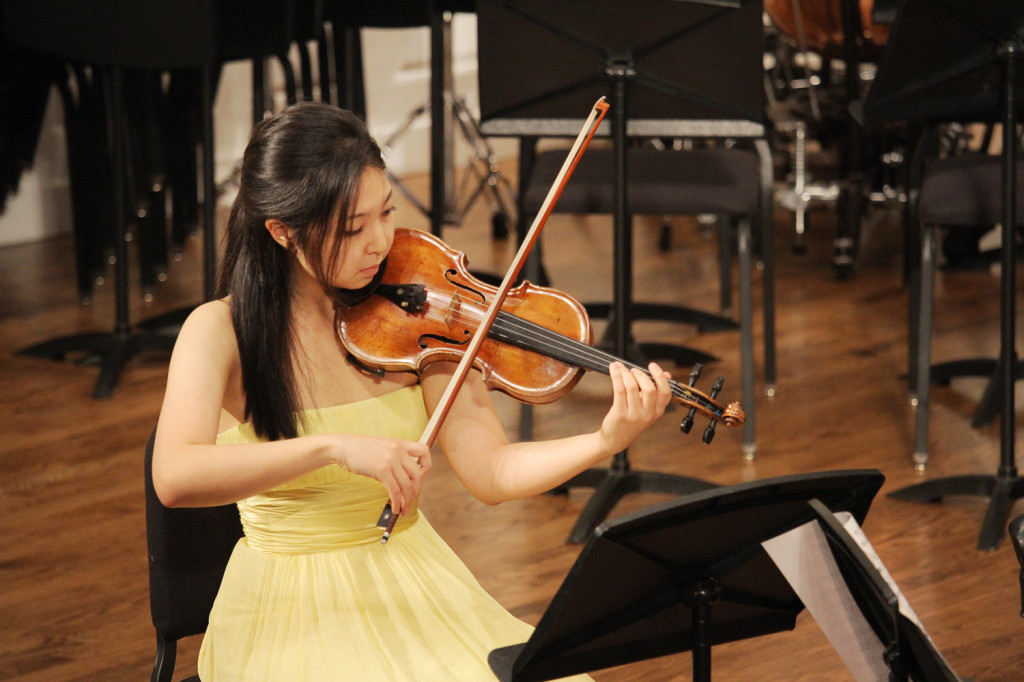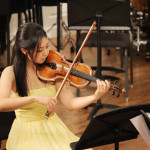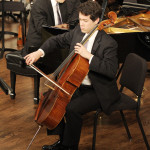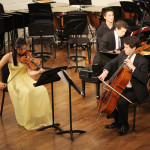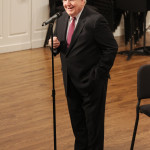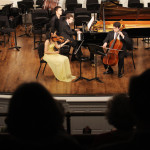Nested in the heart of campus, a box-shaped building rises out of a granite plaza, strangely out of place among the neo-classical grandeur of Commons and the Gothic elegance of the Yale Law School. It is the Beinecke Rare Book and Manuscript Library, half a century old and home to books nearly half a millennium old.
In honor of its 50th anniversary, the library has hosted various events this year — from a reading by the Poet Laureate of the United States to a conference about the use of literary archives in teaching and research — culminating in a gala concert this past Saturday at Sprague Hall. The concert, which featured Yale musicians performing works inspired by Beinecke’s collections, drew both current and former Beinecke employees as well as members of the Beinecke family, who funded the opening of the library in 1963.
Over the last fifty years, Beinecke has become a defining part of Yale, as inextricably linked with the university as Harkness Tower or Sterling Memorial Library. It has grown from an architectural anomaly to a postcard-worthy landmark, from a repository of medieval manuscripts to a rapidly growing collection that incorporates modern culture — a library that straddles the divide between past and present.
“Beinecke is the library that will always need more space,” said Guido Calabresi ’53, LAW ’58, who was a professor at the law school when construction began on Beinecke. “Rare books don’t disappear, because there will always be new ones to collect.”
A CONTROVERSIAL CONSTRUCTION
In 1959, the three Beinecke brothers — Edwin (1907), Frederick (1909) and Walter (1910) — and then University librarian James T. Babb ’25 approached the Yale administration with a proposal to fund a new rare book library. The old Rare Book Room in Sterling was out of space, and the brothers, regular donors to the University library, had long wanted to create a separate library. The University consented — but only on the condition that the brothers pay for the entire construction and ongoing maintenance themselves, said Beinecke Director E.C. Schroeder.
The brothers personally selected the location and architect — Gordon Bunshaft, a modern architect from the architectural firm Skidmore, Owings & Merrill — and construction began in 1960.
Not everyone was happy about the new library, however. The site that the Beineckes had chosen had been promised to the law school for expansion, Calabresi said.
When he found out that the land was being taken away, Calabresi said he approached Babb to ask how this had happened.
“He smiled and said, ‘I have been dining with the Beineckes for 15 years.’” Calabresi said. “In other words, ‘I have been courting them, they’re willing to give the money, they wanted it in this place, and that’s why it’s there.’”
The library’s location was not the only source of controversy. Its distinctive appearance caused some disagreement between librarians and the architect as well.
The librarians, Schroeder said, simply wanted a reading room and stacks to hold the books; they weren’t looking for a “great architectural monument.”
“But that’s why [Bunshaft] was an architect, and the librarians were librarians,” Schroeder said.
Some aspects of the building, though, were praised from the beginning. The library’s dramatic inner core — a six-story glass box which houses the books — as well as the sunken courtyard outside, were popular all along, Calabresi said.
Also popular were the thin marble panels that line the building in place of windows, protecting the books by filtering sunlight and keeping the interior of the library dim, he added.
“The inner core was wonderful, the [panels’] translucence was wonderful, but the building itself people said looked like a bonbonniere, a candy box,” Calabresi said. “That was something that was especially criticized by architects. But in time I think it came to be much appreciated.”
In fact, the building’s distinct design is precisely what appeals to many people today; though it does not necessarily match the surrounding architecture, it adds its own character to the plaza, according to Aaron Pratt GRD ’16. “I’m rather keen on the Beinecke — it’s my favorite building on campus,” Pratt said. “Certainly the Bunshaft design is a different sort of thing than the neo-Gothic and neo-Classical buildings around it, but in a rather basic and probably unsophisticated way, I appreciate it for this very reason.”
FROM GUTENBERG TO THE DIGITAL AGE
When Beinecke was founded, people were delighted with the idea of a rare book library that would reflect the University’s mission and focus, Calabresi said. It was a time when, “if you looked at Yale, you thought of English, history, literature, French and so on,” he said.
Historically, Beinecke’s strengths have lain in its Western European and American pre-20th century collections, with treasures like the Gutenberg Bible and John J. Audubon’s “Birds of America” on permanent exhibition.
But in the last decade or so, the library’s curators have made an effort to expand into more modern and post-modern material, Schroeder said. In addition to acquiring more recent collections, such as post-World War II counterculture pieces, curators have also brought in previously unrepresented writers. One notable addition, for example, has been the recent acquisitions of Native American literature, said Melissa Barton, curator of the American Literature colection. She has also recently added pieces ranging from photographs of dance marathons and roller derbies to African American and lesbian pulp fiction.
“Since we have a mandate to develop the library’s holdings for the entire history of American literature, we are constantly looking to acquire material that, while modern now, will some day be viewed as historically significant,” Barton said. “We see all of these materials as important parts of the historical record and, therefore, worthy of being housed at the Beinecke.”
On the European side, Kevin Repp, curator of Modern European Books and Manuscripts, said the library has amassed a significant collection of counterculture material — from correspondence by Richard Neville, founder of a London underground magazine, to concrete, visual and sound poetry by French and Italian artists.
“It really brings our modernist holdings into the second half of the twentieth century, which is much less explored, since we are often still too close to it to appreciate it,” Repp said. “That period has continuities with the pre-war period that Beinecke traditionally has strengths in, but it’s also very distinct and had a remarkable impact on the culture around us today.”
The material is nontraditional both in its subject matter — for example, transgender issues are addressed in the recently acquired Laura Bailey papers — and its format, catalog librarian Tom Bolze said. Beinecke has begun to move away from pure books and towards more personal correspondence, drafts, and other unpublished material.
The format of Beinecke’s collections, Schroeder said, has also begun to shift in a radically different way — digitally. On the one hand, the library is redefining what the definition of an archive is, he said: Rather than just paper and ink, curators are now collecting emails and hard drives so that in the future entire collections may be contained in a single digital file.
On the other, Beinecke has a digital studio, with three photographers scanning existing print material daily to make it freely available through the library’s website.
“You could be anywhere in the world, and if you wanted to see a manuscript we had, you could do that,” Schroeder said.


Watch this video on YouTube
OPENING UP BEINECKE
While the library’s website opens the Beinecke’s collection to the world, the staff has tried to increase its appeal to people on campus as well, in an attempt to combat what some students see as Beinecke’s inaccessible nature.
“The fact that there are only certain areas of Beinecke that you can go in, and that you can’t take books out, and that there’s limited study room, has meant that I haven’t really seen Beinecke as a place where you can study or touch books,” Ifeanyi Awachie ’14 said. “It’s just surrounded for me by this atmosphere of restrictedness. It’s pretty, and the books are so cool, but I’ll think about it and decide that I’m not going to Beinecke. I’m going to Bass [Library].”
This sentiment was echoed by six of seven students interviewed by the News around campus; students said they had not visited Beinecke either because they had no reason to, were more familiar with other libraries, or felt that Beinecke was not a welcoming environment for studying. The only student who had visited, Ishan Kumar ’15, was a history major whose research had necessitated the trip.
For Basie Bales Gitlin ’10, an avid book collector and historian of Yale, this is not necessarily a problem: The nature of the library’s contents and the work that goes on inside fits its isolation, he said.
“I think it’s designed to be inaccessible,” Gitlin said. “The best space in the library — the open exhibition area on the second floor — is far removed from books or research. The research area is, by design, exclusive. It’s not a welcoming space.”
But the Beinecke staff is determined to change this perception by hosting various open houses throughout the year and encouraging undergraduates to take tours. The library’s staff also wants students to see how easily they can engage in research, Schroeder said.
To this end, he emphasized the four classrooms within Beinecke in which professors can teach from the collections and students can interact directly with the materials. There was only one infrequently used classroom when Beinecke was first built, he said; but last year over 400 courses engaged with the Beinecke in some way, and renovations are planned for 2015 to add two more classrooms.
“The opportunity to teach at the Beinecke was a large part of my decision to leave Columbia [University], which I loved,” said David Kastan, who has taught a class at the library every year since he came to Yale in 2008.
Kastan’s graduate course this semester, “Making Shakespeare,” focuses on how Shakespeare’s texts have been printed and presented since their original publication in the 16th century. With Beinecke’s collections, students in the class have the opportunity to engage with the texts in their original formats.
“I should emphasize just how rare of an opportunity it is to work directly with the remarkably wide range of Shakespearean texts at the Beinecke,” said Andrew Brown GRD ’19, a student in Kastan’s class. “Graduate students can undertake research projects at the Beinecke that wouldn’t be possible at almost any other research library in North America.”
In the past fifty years, Beinecke has adapted to new developments in academia and technology, establishing itself as one of the foremost college libraries in the world. But while bringing in new materials and expanding its scope, it is still remaining true to its roots as a center for the humanities, Schroeder said.
“Because the Beinecke is an architectural monument in the center of campus, it’s basically reaffirming the importance of the humanities and books and manuscripts to a liberal arts education,” Schroeder said.
